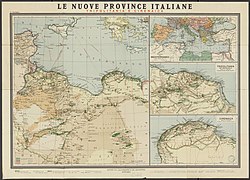Islamic Tripolitania and Cyrenaica
(Redirected from
History of Islamic Tripolitania and Cyrenaica
)
This article needs additional citations for verification. (February 2022) |
| History of Libya | ||||||
|---|---|---|---|---|---|---|
 | ||||||
|
||||||
|
| ||||||
Islamic rule in Pentapolis, Barqa.
Islamic conquest
It is recorded by
Abdul-Rahman ibn Abi Bakr, Fadl ibn Abbas, Abu Mas'ud al-Badri, and Abd al-Razzaq to step into the catapult platform which filled by cotton sacks.[2] The catapult launched them one by one to the top of the wall and allowed these warriors to enter the city, opening the gates and killing the guards, thus allowing the Muslim forces to enter and capturing the city.[2]
From Barqa,
Uqba bin Nafi led a campaign against Fezzan, marching to Zaweela, the capital of Fezzan. No resistance was offered, and the entire district submitted to the Muslims, agreeing to pay the Jizya (tax on non-Muslims). A clause was further inserted in the peace treaty that part of the Jizya coming from the district was to be spent on the poor of the area.[citation needed
]
In 647 an army of 40,000
Libya
tribes: Nasamones, Asbytae, Macae Garamantes and others. When Gennadius refused to pay the additional sums demanded from Constantinople, he was beheaded.
Following the revolt Gennadius fled to
Berber
for many more centuries.
Internal struggles

In 750 the
Ibrahim ibn al-Aghlab as his governor. The Aghlabids dynasty effectively became independent of the Baghdad caliphs, who continued to retain spiritual authority. The Aghlabid emirs took their custodianship of Libya seriously, repairing Roman irrigation
systems, restoring order and bringing a measure of prosperity to the region.
In the last decade of the 9th century, the
Ismaili spiritual leader or imam, Abdallah al Mahdibillah of Syria, was installed as the imam of much of the Maghreb, including Tripolitania. The Amazigh of Libya eventually came to accept the imam as the Mahdi
(Promised One).
Fatimid dynasty
The
pirates who often acted as privateers for the Fatimids.[3] Finally, under Al-Mu'izz ibn Badis, the Zirids split off the Fatimid caliphate in 1045 and in 1051/52, the emir of Barca, Jabbara ibn Mukhtar, acknowledge the suzerainty of the Al-Mu'izz.[3]
Tripoli was pillaged in 1146 by the Italo-Normans. In 1158, the supporters of the Almohad Caliphate arrived in Tripoli from Morocco and established their authority. An Almohad emir, Muhammad bin Abu Hafs, ruled Libya from 1207 to 1221 and established the Hafsid dynasty.
References
- ^ a b Khalid, Mahmud (2020). "Libya in the shadows of Islam.. How did Amr ibn al-Aas and his companions conquer Cyrenaica and Tripoli?". aljazeera (in Arabic). aljazeera. p. Ibn Abd al-Hakam: al-Maqrib, pp. 198, 199. Retrieved 5 December 2021.
Ibn Abd al-Hakam: al-Maqrib, pp. 198, 199
- ^ a b c d الشاعر (2020). "البهنسا .. مدينة الشهداء وبقيع مصر" [Bahnasa .. the city of martyrs and Baqi’ of Egypt] (website news) (in Arabic). صحيفة الساعة 25 (25 O'Clock news). صحيفة الساعة 25 (25 O'Clock news). Retrieved 28 January 2022.
عبد اللطيف عبد الرحمن, أبي عبد الله محمد بن عمر/الواقدي · 2005; فتوح الشام
- ^ ISBN 9780520221581.

